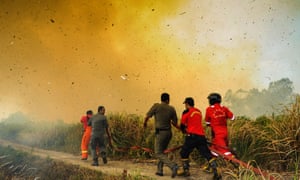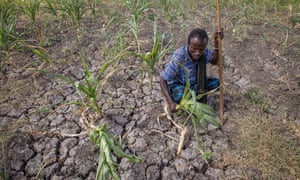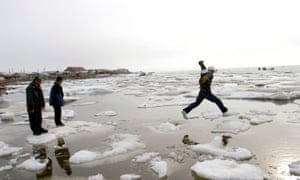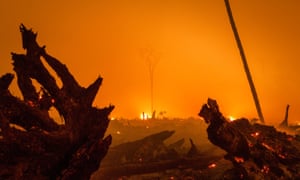Our planet went through a dramatic change last month. Climate experts revealed that February was the warmest month in recorded history, surpassing the previous global monthly record – set in December. An unprecedented heating of our world is now under way.
With the current El Niño weather event only now beginning to tail off, meteorologists believe that this year is destined to be the hottest on record, warmer even than 2015.
Nor is this jump in global temperature a freak triggered by an unusually severe El Niño, say researchers. “It is the opposite,” said Professor David Vaughan of the British Antarctic Survey. “This is a catch-up of a recent hiatus that has occurred in rising global temperatures. We are returning to normality: rising temperatures. This is an absolute warning of the dangers that lie ahead.”
Those dangers are now being dramatically demonstrated around the globe: drought in the Marshall Islands in the Pacific, which has forced the government there to issue a state of emergency warning; France observed its warmest winter since records began; while the sea ice that has formed in the Arctic this winter is about a million square kilometres less than its average for this time of year.
This latter feature is likely to have particularly profound consequences. “A low sea-ice level in winter will definitely promote a low level of sea ice next summer,” said Vaughan. “Arctic summer ice – which is dwindling dramatically – is changing the region.”
In particular, disappearing sea ice allows more and more ships to get to once unreachable regions in high latitudes. As a result, plans to drill for oil and gas in the Arctic – a prospect that horrifies many scientists and environmental groups – are being prepared by most major oil companies.
Last month’s jump in global temperatures represents an increase of 1.35C above pre-industrial levels and takes the world close to the 1.5C rise that last year’s Paris climate deal was supposed to prevent. “Last month’s figure is a one-off and it remains to be seen if temperatures are going to continue to rise this steeply,” said Professor Richard Betts, head of climate impact research at Exeter University. “We are still not at an established 1.5C rise, but there is no doubt this is a worrying sign.”
Scientists and politicians are keen to hold global warming to 1.5C above pre-industrial levels because they fear that a world that warms to such a level will experience severe loss of ice, particularly from Greenland’s massive shield of glaciers, and that the melting will in turn trigger considerable rises in sea levels.
Scientists warn there are many island states in the Pacific that will simply disappear if the planet undergoes that sort of warming. In addition, if the temperature increases to 1.5C, it will combine with ocean acidification driven by rising carbon dioxide emissions to dissolve the world’s already threatened coral reefs. “That is why last month’s temperature level was so significant – and worrying,” added Betts.

INDONESIA
The Indonesian government announced last week it was taking emergency action to deal with an alarming rise in the number of fire-risk danger spots across the country. Last October forest fires blanketed Indonesia and neighbouring Malaysia, Singapore, Thailand and the Philippines in smoke and haze. Dozens died from burns or toxic fumes. The fires were initially triggered by farmers clearing land but spread uncontrollably because vegetation had dried with the advent of El Niño last October. This, in turn, occurred against a background of global warming linked to rising carbon dioxide levels in the atmosphere. The result was a conflagration that cost Indonesia billions of dollars. Now some of the worst affected regions, East Kalimantan and Riau, have reported a worrying return in numbers of fires and hotspots. As a result, the government has announced that it is gearing up to deal with outbreaks of fire.
“With rising global temperatures caused by carbon emissions, El Niño helped to turn Indonesia into a tinder box,” said Professor Richard Betts, head of climate impact research at Exeter University. “That threat could soon return.”

ETHIOPIA
Gillian Mellsop, Unicef representative to Ethiopia, is under no illusions about what is happening to the country: it is experiencing one of the worst droughts in its history. More than 10 million people need emergency food assistance, she told the Observer. In particular, an estimated 435,000 children under five will need treatment for severe acute malnutrition. Nor is Mellsop in any doubt about the reason for this crisis. “Ethiopia has been hit by a double blow, both from a change to the rainy seasons that have been linked to long-term climate change and now from El Niño, which has potentially led the country to one of the worst droughts in decades,” she said.
“As carbon dioxide accumulates in the atmosphere, background temperatures rise. Each new El Niño then superimposes itself at a hotter level and so triggers more and more damage.”
Last year, with the rise of El Niño, Ethiopia’s rains failed. Crops withered and cattle died. One estimate suggests that 5.8 million people now need help with water and sanitation provision, and 3.9 million children and adolescents cannot get access to education because of the drought.

ALASKA
No region on the planet has warmed as much as the Arctic. In some areas temperatures almost 7C above average have been recorded. Sea ice cover in the Arctic – which should be reaching its maximum in a couple of weeks – last month stood at a record low for the second consecutive month. Similarly in summer, sea ice cover has dwindled. Overall, the Arctic’s sea ice cap has shrunk by nearly a third since 1979, according to the US National Snow and Ice Data Centre. And that is a real problem. Ice is the life support platform on which Inuit and local wildlife depend.
Sea ice allows indigenous people to travel on snowmobiles to visit relatives in winter. Last week the Guardian reported on one couple in Alaska who narrowly escaped when their snowmobile plunged into soft ice that would normally have been frozen hard. Similarly, permafrost is melting and buildings are collapsing while wildlife species– including polar bears – are suffering from the disappearance of the ice platforms on which they once relied for hunting or protection.
Across the Arctic, the fabric of life is disintegrating.
SNAPSHOT OF A WARMING WORLD
Across the planet, nations have experienced a wide variety of impacts as the world has gone through unprecedented heating. According to the US National Oceanic and Atmospheric Administration, most of Earth’s land surfaces were warmer than average, with record warmth notable across various areas of South America, much of southern Africa, southern and eastern Europe, around the Urals of Russia, and most of south-east Asia, down to northern Australia.
A vast region stretching from central Russia into eastern Europe, along with most of Alaska, experienced February temperatures more than 5C above the average for 1981 to 2010.
New Zealand (1) observed its second warmest month since national records began while in Toronto, Canada, (2)temperatures reached 16C, the highest temperature ever for February. Similarly, the average February temperature in Venezuela and northern Colombia (3) was about 3C higher than the 1981-2010 average. Not every nation enjoyed the heat, however. Temperatures were below average in southern Argentina (4), for example. Similarly, all official reporting stations in Iceland recorded below average temperatures for the month. The average sea surface temperature for December to February was 0.84C above the 20th century average of 15.8C, with record highs for large swaths of the tropical Pacific Ocean (5), various regions of the North and South Atlantic, much of the Indian Ocean, and the Barents Sea in the Arctic (6).
Meteorologists noted strong El Niño conditions across equatorial Pacific in February although temperatures began to drop from the highs of 2015 suggesting it was coming to an end.

